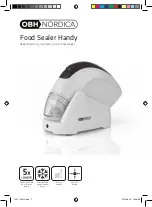
10
Tips for Best Results
• Before vacuum packing fish remove its innards.
• Do not leave too much air inside the bag. Reduce air in the bag by squeezing it out
carefully before vacuum sealing. Too much air inside the bag may overload the vacu- um
pump and avoid the generation of vacuum.
• There are many non-food uses for the appliance. Keep camping supplies such as mat-
ches, first aid kits and clothing clean and dry. Keep silver and collectibles untarnished.
CAUTION: Do not vacuum pack inflammable liquids (e.g. alcoholic beverages, sol-
vents). Caused by low pressure, large amounts of liquid will evaporate and build-up a
hazardous explosive mixture. Additionally, the appliance could be damaged.
• When vacuum packing objects with sharp edges and points like fish bones and hard
shells, carefully pack these objects with kitchen cloth! Sharp edges and points may
penetrate and tear the bag! Alternatively use a container.
• You cannot generate side seams with the appliance. The pre-sealed seams of the desi-
gnated foils are welded in a special way for usage with the appliance.
• Only a container OR a bag can be vacuum sealed at a time. These modes of operati-
on cannot be used simultaneously.
• Place a filter bag on top of powdery or fine ground food, before vacuum packing.
This way the vacuum pump cannot suck in the particles.
• Fill a bag about 2/3 full with water, and thereafter seal the end, but don‘t use the
Vacuum Seal button. Freeze the bag and use for ice in the cooler, or ice packs for sports
injuries.
CAUTION: Only use the Seal Only button for this. Ensure not to spill the water on or in
the appliance.
• Frothy food and beverages are not suited at all for vacuum packing. Example: cookies
made from beaten egg white.






































